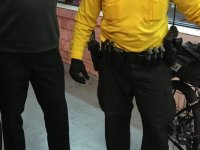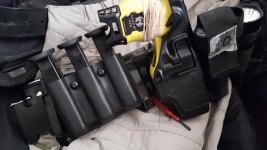On April 11, 1986, a gun battle took place between FBI agents and a pair of hardened armed robbers and murderers in Miami, Florida. It would be as highly publicized as the gunfight at the OK Corral more than a century before, and it would take more lives.
In the course of that shootout, a perpetrator emptied and reloaded a Ruger Mini-14, using up at least one Federal Ordnance 40-round magazine along the way, according to reports. Of the eight involved agents, one was unable to return fire but seven more did. Here is how they fared.
--One agent emptied his .357 Magnum revolver and wounded one of the killers. Shot in the gun hand, he was unable to reload before he was shot in the neck and permanently injured by the perpetrator with the Mini-14.
--One agent lost his service revolver and continued the fight with his 5-shot Chief Special .38 backup revolver. He fired all five shots without being able to neutralize the opponents. He was shot and gravely wounded while attempting to reload with loose cartridges.
--One agent fired all six shots from his service revolver and had to reload with loose cartridges, despite having been wounded. He did not, apparently, hit either of the killers.
--One agent fired a few shots with his S & W M459 9 millimeter pistol, but had lost his glasses in the ramming of the suspects' vehicle that had preceded the shootout and was apparently unable to identify his targets. He was shot down by the killer with the .223 rifle before he could utilize his extensive training to effectively engage his adversaries.
--One agent emptied his 15-shot Model 459, reloaded, and emptied a second magazine. One of his 9mm Silvertips tore through the primary antagonist's right arm and into his chest, severing the plural artery and causing a mortal wound that did not take immediate effect. It was after this bullet hit him that the killer shot down five of the seven wounded agents, two of whom died. When he shot THIS agent, the latter's pistol was empty, it's slide locked back on it's second and last magazine.
--One agent emptied his Model 459, wounding the primary gunman once and possibly rendering him incapable of shooting any longer with that hand; he was subsequently observed to fire weak hand only. This agent's slide locked back after 15 rounds and he drew his Smith & Wesson Model 60 Chief's Special from his ankle holster and fired one .38 Special round at the suspects before reloading his 9mm auto. This agent who took effective cover and a controlling posture, would be the only involved FBI man to survive the firefight unscathed.
--One agent, severely wounded in the left arm by .223 fire early in the firefight, emptied his Remington 870 pump shotgun one-handed, wounding both perpetrators but not neutralizing either. This heroic lawman ended the fight by staggering up to the getaway car and shooting the gunmen three times each with lead hollowpoint 158-grain .38 Special bullets from his service revolver, killing both instantly. As he collapsed near their corpses, the sixgun in his hand had been emptied.
The gunbattle had been a lasting lesson in the importance of firepower. FBI subsequently authorized field agents to carry high capacity 9mm autos or 8-to 9-shot .45 autos for the first time in the Bureau's history. The agents using 9mm pistols in the Miami fight were specially authorized to do so because they were SWAT members. In addition, agents were issued the HK MP5SF, a compact 9mm semiautomatic carbine with a 32-round magazine.
I remember someone writing about Ayoob's poor write up of the Miami shootout, this is good evidence that person was right. The guy with the Chief's Special had a 38 FBI load that ended up punching through a bunch of tissue and ended up bouncing off his skull and bruising his central nervous system, knocking him out for most of the fight, when he did reawaken he was basically incapacitated and only managed to stumble his way from the bank robber's car into the FBI agent's car. One of his 5 shots made a huge difference that day.
The real nonsense here is that Dove's Silvertip was the bullet that killed the robber with the Mini-14, not the agent at the end of the fight with the 870 Remington who fired the last shots. The Silvertip fatally wounded him but came within an inch of his heart and stopping him before he killed the two agents, so the bullet failed that day. Dove's gun WASN'T empty, it was struck by a bullet and malfunctioned, no amount of magazine capacity or even a dozen extra magazines would have helped him after his gun was jammed up beyond fixing. Grogan wasn't completely out of the fight because he lost his glasses, he was busy trying to help Dove unjam his wrecked S&W pistol when they were both overran by the mortally wounded bank robber and killed.
The bank robber with the Mini-14 wasn't killed instantly by a shot from the revolver by the wounded agent who also fired the shotgun, he bled to death from the earlier wound, so this is pure nonsense. The agent didn't collapse near the corpses of the robbers, both were in the seat of an FBI car, one dead and the other still so alive that paramedics tried to save him after the fight was over, before that fatal wound finally bled him out.
Lot of factual errors and oversights, but then again experts can't be right all the time either.
Some good cases for extra ammunition, but be careful of cherry picking. Keep in mind, as I mentioned earlier about string shooting, a rapid firing officer might find himself out of ammunition very quickly as well, wonder if there are any case studies on situations where people have burnt through 45 rounds of ammunition before being killed or overrun by an attacker? The 15 round magazine, high capacity 9mm's didn't save the FBI agents that day in Miami. Plenty of good men in the field DIDN'T kill the guy on the 28th shot, or the last shot in their gun. Plenty of times when the extra rounds in a magazine or the extra magazines carried with didn't save the day.
I agree the main advantage of extra capacity, but more the advantage of more magazines, is that one can cover oneself and others in a heavy engagement, more rounds means more time. In that case, how much of an advantage is a 20 round magazine over a 15, or a 15 over a 13, or a 13 over a 10? Is the 45 ACP, 9 round magazine with the officer carrying more magazines at that great of a disadvantage? Or for that matter, is the 9mm 15 round magazine at any real disadvantage than the 18 or 20? Again, modern training is to dump a magazine under cover wither its empty or not. In some cases we see the officer getting the stopping shot after a reload and cooling off, not snapping off the last round in the magazine after a string.
Good case studies listed, but more study and more cases can only teach you more. And its good to make sure you get the facts straight before drawing too many conclusions.



